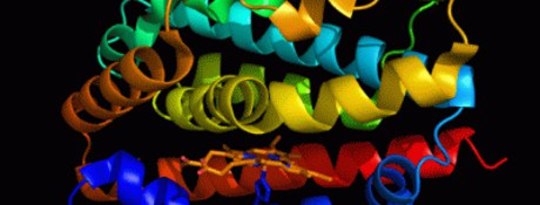
Some obese people may be able to remain metabolically healthy despite their size because their bodies produce low levels of a certain molecule, according to a study published today in the journal Cell.
High levels of the molecule, called heme oxygenase-1 or HO-1, are linked to metabolic illnesses such as diabetes and heart disease, as well as high blood pressure, blood sugar and cholesterol, which lead to these diseases.
Early tests in mice show that blocking HO-1 can improve metabolic healthiness. This suggests a potential new strategy for treating obesity-related disease.
Past research has estimated 25-30% of obese people have no metabolic illnesses or risk factors. But the reasons were unknown. So the research team from the Medical University of Vienna and the Max Planck Institute of Immunobiology and Epigenetics in Freiburg, Germany, set out to investigate whether HO-1 was responsible.
In studies of human tissue, they found higher levels of HO-1 in liver and fat biopsies from people who were obese and insulin-resistant compared with obese people who were metabolically healthy.
Of Mice and Men (and Women)?
Using mouse models, the researchers then deleted the HO-1 gene in immune cells called macrophages. This left the mice with better liver function and an increase in insulin sensitivity, indicating improved metabolic health.
As one of the strongest predictors of unhealthy obesity, the researchers said the HO-1 molecule was now a candidate biomarker for identifying metabolically unhealthy obese people to detect the onset of disease.
“This could allow clinicians to use targeted interventions to prevent disease progression specifically in obese individuals who show early signs of type 2 diabetes,“ senior study author J. Andrew Pospisilik, from the Max Planck Institute, told Cell.
The team is now investigating whether HO-1 levels could be manipulated and reduced in humans using drug therapies.
Hypothesis Requires Further Investigation
Principal research fellow at the Garvan Institute Professor Lesley Campbell, who was not involved in the study, said the research was significant, but HO-1 manipulation in humans was still a hypothesis requiring further investigation.
“Particularly because they haven’t got great evidence yet that knocking the gene out in humans or blocking it in humans would make a big difference,” she said. “There should be more work done on it, following this line of thought, but it has to be done in a longitudinal way, where we watch what happens to this marker under different conditions.”
Professor Campbell said breakthroughs in obesity treatment were rare because when potential treatments altered this vital human response system, they also caused unwanted side effects.
“When you really hit a system, you want to make sure you don’t interfere with another system that’s vital too,” she said.
Producing More “Empty” Fat Cells?
Melbourne University Professor of Medicine Joseph Proietto said an alternative theory for healthy obesity was that these people were capable of producing more “empty” fat cells that mop up the excess fat.
But even obese people who were metabolically healthy were at risk of other illnesses, he said.
“Obesity affects all tissues so complications that are not directly linked to metabolic problems may still be present such as obstructive sleep apnoea, increased risk of cancer, and so on.”
Associate Professor Anna Peeters, Head of Obesity and Population Health at Baker IDI Heart & Diabetes Institute, said the researchers' treatment target to improve the metabolic outcomes of those with obesity was thought-provoking.
This is “likely to be very important, given how hard it is to prevent obesity”, she said.
“In Australia, over one quarter of adults have obesity and over one third [are] overweight. Over one quarter of Australian children are overweight or obese.
“At the moment there are very few treatments for obesity, although it is well recognised that even moderate weight loss can achieve health benefits,” Associate Professor Peeters said.
“For those living with obesity, it is clear that a healthier diet, higher levels of physical activity and fitness, lower levels of sitting time and less abdominal fat are associated with a healthier metabolic profile,” she said.
This article originally appeared on The Conversation
(Subtitles by InnerSelf)
About the Author
 Fronscesca Jackson-Webb joined The Conversation from the Australian Medical Association, where she managed the Victorian media office. She previously worked for BBC Magazines in London and Melbourne consultancy Twenty20 Communications.
Fronscesca Jackson-Webb joined The Conversation from the Australian Medical Association, where she managed the Victorian media office. She previously worked for BBC Magazines in London and Melbourne consultancy Twenty20 Communications.
Recommended book:
The Harvard Medical School Guide to Tai Chi: 12 Weeks to a Healthy Body, Strong Heart, and Sharp Mind
by Peter Wayne.
 Cutting-edge research from Harvard Medical School supports the long-standing claims that Tai Chi has a beneficial impact on the health of the heart, bones, nerves and muscles, immune system, and the mind. Dr. Peter M. Wayne, a longtime Tai Chi teacher and a researcher at Harvard Medical School, developed and tested protocols similar to the simplified program he includes in this book, which is suited to people of all ages, and can be done in just a few minutes a day.
Cutting-edge research from Harvard Medical School supports the long-standing claims that Tai Chi has a beneficial impact on the health of the heart, bones, nerves and muscles, immune system, and the mind. Dr. Peter M. Wayne, a longtime Tai Chi teacher and a researcher at Harvard Medical School, developed and tested protocols similar to the simplified program he includes in this book, which is suited to people of all ages, and can be done in just a few minutes a day.
Click here for more info and/or to order this book on Amazon.























